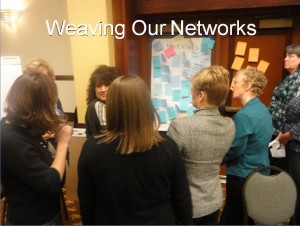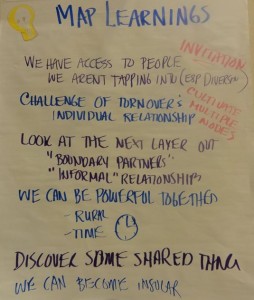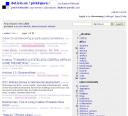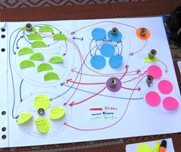 I have been enjoying working with the Thrive by Five Washington coalition for the past 5 months. My little piece is to work on network weaving practices within the regional coalitions and across the state as they emerge and form. We had a fun session on network weaving a couple of weeks ago and I thought it might be interesting to share the story.
I have been enjoying working with the Thrive by Five Washington coalition for the past 5 months. My little piece is to work on network weaving practices within the regional coalitions and across the state as they emerge and form. We had a fun session on network weaving a couple of weeks ago and I thought it might be interesting to share the story.
First a little history. This February session built on what we did last November where we mapped networks and started thinking about who “was in the room” and who we wished was with us.
We began with some postits that listed various demographic indicators – all mixed up and not separated by region. We asked people to pick the demographic indicators that they thought represented their region, as some of our state’s make up has been shifting pretty impressively in recent years. It is easy to hold on to old perceptions…
Most of the regions were savvy and picked out their data. Then then posted their data on a big sheet of paper prepared for each coalition. We asked them to think of one of the demographics that they wanted to do more with in their area (i.e. teen moms, families where no English is spoken at home, etc.)
 We asked each group to map their coalition They used post it notes – one per person or organization – and identified the main players in their network. As time allowed, they moved post its closer where there was more engagement and deeper relationships, moving those “less connected” to the periphery, all the while discussing the implications of what they were mapping.
We asked each group to map their coalition They used post it notes – one per person or organization – and identified the main players in their network. As time allowed, they moved post its closer where there was more engagement and deeper relationships, moving those “less connected” to the periphery, all the while discussing the implications of what they were mapping.
Finally, we asked them to consider the demographic group they identified. How did this group show up (or not show up) on their map? Who were “connectors” out into these subcommunities? If there were none, who might they invite into the coalition to help serve this role. Again, new ideas were generated and people began to both see their coalition, AND the power of what they brought as individuals with their own social networks. The logical follow up request was to ask them to act on these ideas in their coalitions going forward.
 In the meeting debrief, people reported that the mapping exercise was useful so we decided to do a follow up session at the February 2011 meeting.
In the meeting debrief, people reported that the mapping exercise was useful so we decided to do a follow up session at the February 2011 meeting.
While we knew we would not have exactly the same people as we did at the first meeting (coalitions can’t always send the same people!), we wanted to complement the visual mapping work from November with some very practical network weaving practices at this meeting. We did need to some common ground, so I prepared a few introductory slides. My main content centered around June Holley’s work, and her current draft Network Weavers Handbook. Thrive by Five WA is part of a community of practice of non profits around the country working to build skills in network weaving (NWWCoP.org).
One of the dynamics in this coalition is that it is reshuffling things. There are many strong local and county coalitions for those interested in readiness for learning for children birth to third grade. However, there are funding and advocacy drivers that suggest regions are a more powerful entity. Regions cross and blend all these old coalition lines, so there are both opportunities and challenges.
 One thing I’ve been noticing in working with the coalitions is that there needs to be a way to discern what needs to be kept in the more formal, organizational hierarchy domain, and what merits “setting free” into a more emergent and informal network. There is need for both, but education and health care practices tend to be valued most when they are codified. So I also grabbed June’s table comparing when networks or organizations are the most useful strategic approach.
One thing I’ve been noticing in working with the coalitions is that there needs to be a way to discern what needs to be kept in the more formal, organizational hierarchy domain, and what merits “setting free” into a more emergent and informal network. There is need for both, but education and health care practices tend to be valued most when they are codified. So I also grabbed June’s table comparing when networks or organizations are the most useful strategic approach.
I made handouts of three of June’s worksheets: one on assessing one’s network, one on closing triangles and one on matching assessed needs with practical follow up actions. I also created a “coalition health checklist.” We had heard feedback that some of the coalitions in the start up phase were struggling a bit, so the checklist was again a way to surface and prioritize issues. (Coalition Health Check Up)
I had people do the network assessment individually, then pair up with a partner to talk through it. I find the checklist needs that “lets bounce this around” sort of conversation to get past an easy “check the box” approach. We joined back up to report out on the activity and this immediately led us into some of the network weaving strategies such as “closing triangles.” Then I asked people to think of two individuals they want to introduce and we talked about introduction strategies – from the easy, breezy email to actually inviting people to do something tangible in the coalition.
One thing that came up from a couple of folks was the fact they felt everyone assumed that all the connecting was their job. The challenge of being a hub in a hub and spoke network, which works well at the start, but wears out the poor hub and does not scale nor sustain. One strategy is to start closing triangles with others who can start taking on the connector role!
We worked through the opportunity checklist and closed by asking everyone to think of one network weaving activity they’d like to see happen in their coalition and report back – as the final session of the day brought everyone back from breakouts into their coalition groups. I also encouraged everyone to share how their weaving went at the next coalition meeting. I sent follow up emails with some additional resources and my fingers are crossed that action happens. I’ve already heard from one person that she is going to have an agenda item on network weaving at their next coalition meeting. Needless to say, that made me smile.
 Josie Fraser offers spot on advice to anyone using a social network.
Josie Fraser offers spot on advice to anyone using a social network. 
 If you are interested in social network mapping, subscribe to Eva Schiffer’s blog, the
If you are interested in social network mapping, subscribe to Eva Schiffer’s blog, the